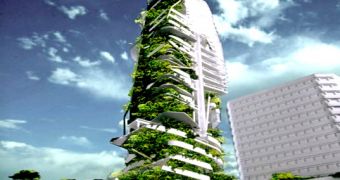Back in 1998, there was a contest called EDITT (Ecological Design in the tropics) which would sponsor ecologically-oriented building projects. The winner was Dr. Ken Yeang from T.R. Hamzah & Yeang International, an ecological architecture company, whose project focused on the building of a large ecological skyscraper in the “zero-culture” zone of Singapore.
Currently, the building, sponsored by EDITT and the National University of Singapore, is undergoing construction phase. The 26-story tall skyscraper will be provided with 855 meters of photovoltaic panels which will ensure about 40% of the electrical power needs. Specially designed architectural features, helped by water misters, will allow for natural wind ventilation and cooling of the floors and of the toilets which will be placed at the edges of the edifice, reducing the energy requirements of the fans installed. Since Singapore is well-known for its frequent heavy shower rains and for importing water from Malaysia, this issue will be addressed by installing specific devices in order to collect rain water, filter it and integrate it into regular use as greywater (sullage), thus providing 55% of the occupants' water needs.
The water will also be used to sustain the massive amount of plants that would decorate the inside and outside of the construction, some of which will also be used (along with sewage) for the generation of bio-gas, while others will form an insulating living wall. Speaking of walls, together with other architectural parts of the Tower, they will be movable or completely removable in order to ensure larger adaptability. They will be constructed out of recyclable materials. Recycling will also be encouraged in the building, with a centralized system available on every floor. Up to the 6th floor, access will be possible by using ramps ascending from the street level as well, which will be populated with plants, shops and restaurants.
The project aims to integrate human-made architecture into the environment in a perfect, co-dependent blend, while rehabilitating a naturally-dead region of Singapore called “zero-culture”, an urban, organic-free place where the ecosystem was totally destroyed.

 14 DAY TRIAL //
14 DAY TRIAL //